Have you ever wondered why some colors are more difficult to find in nature? If you have, then you’ve probably come to the realization that blue is one of those colors, and is also one of the rarest colors for most types of aquarium fish.
This makes these blue-colored fish a well-sought commodity in the fishkeeping world. Such coloring is due to a black pigment combined with what’s known as “iridocytes” in the skin that makes the fish appear blue as a result of the incoming light.

If you’re on the lookout for captivating blue fish, then you’ll find this list useful regardless of whether you’re searching for freshwater or saltwater species.
The Top 19 Prettiest Blue Aquarium Fish
For the purpose of this list, I’ve included types of fish that are entirely blue as well as ones with a mixed color palette.
Without any further ado, here are the most gorgeous blue aquarium fish:
1. Polar Blue Parrot Cichlid
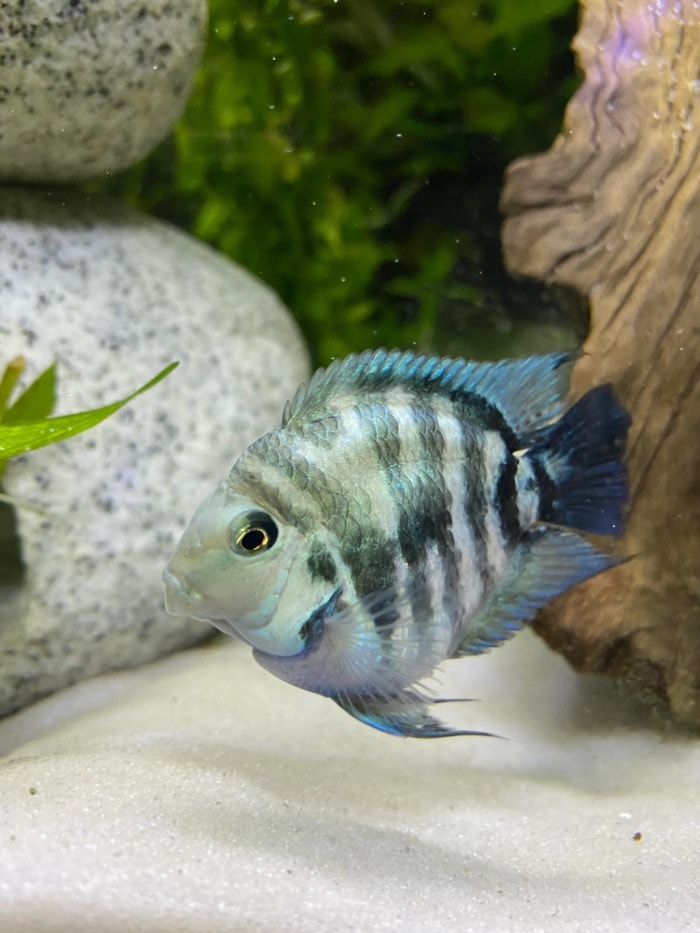
| Max. body size | 4 inches (10.1 cm) |
| Suggested tank size | 30 gallons |
| Water temperature | 76 to 82 °F (24 to 27.7 °C) |
| Setup | Freshwater |
As you may have noticed, The Polar Blue Parrot Cichlid lacks a scientific name in its description.
This is because it is a type of hybrid species that was created by crossbreeding Blood Parrot Cichlids with Convict Cichlids.
Consequently, the Polar Blue Parrot Cichlid shares characteristics of both species.
It has zebra-like stripes and an elongated snout which it has inherited from the Convict Cichlid.
On the other hand, it possesses a compressed body shape that was passed down by the Blood Parrot Cichlid. As a result of the latter, these blue pet cichlids have very specific dietary requirements.
They should be kept on a balanced diet of pellets, flakes, blanched vegetables, and a source of protein. However, their protein intake should be moderate due to the small size of their gut.
Going overboard on the amount of protein in their diet will very likely lead to congestion.
As a final note in regards to their diet, these fish should be fed foods that are rich in carotenoids if you want to keep their colors saturated.
In terms of behavior, Polar Blue Parrots are somewhat aggressive, which isn’t all that surprising given their lineage. If you intend on keeping them in a community setup, you should avoid small and timid fish, as they will probably get harassed by the cichlids.
2. Red Tail Shark – Epalzeorhynchos bicolor

| Max. body size | 5 to 6 inches (12.7 to 15.2 cm) |
| Suggested tank size | 55 gallons or more |
| Water temperature | 74 to 80 °F (23.3 to 26.6°C) |
| Setup | Freshwater |
Red Tail Sharks (Epalzeorhynchos bicolor) usually have a dark blue coat, complemented by a crimson tail, but they can also be found in black.
The sex of Red Tail Sharks can be distinguished by their colors and tail shape.
Males typically have a more slender appearance, and sport brighter colors, while females have a rounder shape.
These pet fish are rather timid in their youth, but once they mature their true nature comes to the surface.
Every trace of their youthful innocence suddenly vanishes and they become vicious predators.
The mature Red Tail Sharks are ready to protect their territory from the advances of other fish, even if these fish just happen to be in their way.
Because of this, Red Tail Sharks aren’t among the most popular beginner fish. If you want to venture forth and diversify your tank with one of these ‘sharks’, you shouldn’t keep it with other bottom-dwelling fish and you should provide it with sufficient space.
3. Blue Whale Catfish – Cetopsis coecutiens
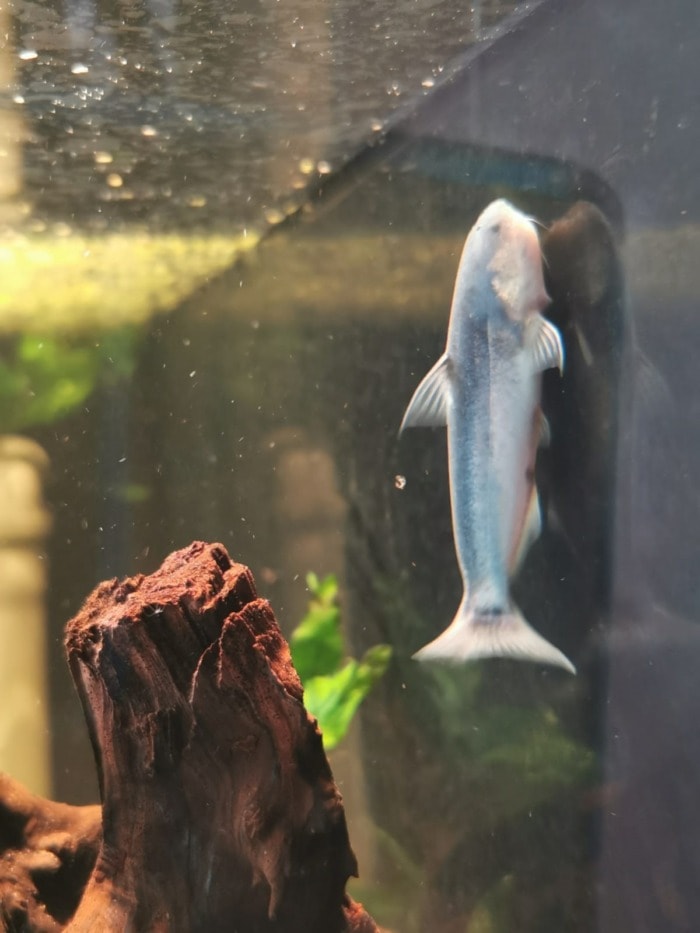
| Max. body size | 10.6 inches (26.5 cm) |
| Suggested tank size | 65-gallon tank at minimum |
| Water temperature | 72 to 79 °F (22 to 26 °C) |
| Setup | Freshwater |
Don’t like sharks?
Then what about whales?
If your answer to the second question is yes, then the Blue Whale Catfish from the Cetopsis genus is just what your tank needs.
Even though these catfish aren’t true whales, they’re the closest thing that you can get in an aquarium.
The rear part of their body is colored in bright blues that overflow to darker hues at the front of their body.
In the wild, Blue Whale Catfish inhabit deep and murky waters, so they prefer environments with low levels of lighting.
Decorating your aquarium with dense vegetation will help diffuse the incoming light and make the Blue Whale Catfish feel right at home.
If you are looking for a calm bottom-dwelling fish, then you should move forward to some of the other entries.
Blue Whale Catfish are extremely aggressive and will even attack fish larger than themselves.
4. Blue Dolphin Cichlid – Cyrtocara moorii

| Max. body size | 10 inches (25.4 cm) |
| Suggested tank size | 125+ gallons |
| Water temperature | 73 to 80 °F (22.8 to 26.7°C) |
| Setup | Freshwater |
If none of the previous two entries has satisfied your hunger for freshwater, marine look-alike species, then this one surely will.
Unlike them, the Blue Dolphin Cichlid is a gorgeous tropical fish that is well-known for its calm nature.
The most notable visual feature of this fish is the bump on its head that fully develops once it reaches maturity.
It usually has a plain, brightly colored body, but some specimens are marked by dark blue vertical stripes. The uniqueness of the Blue Dolphin Cichlid is further exemplified by the fact that it’s the sole member of the Cyrtocara genus.
Despite their otherwise peaceful demeanor, males might still exhibit aggression toward conspecifics.
Keeping a ratio of three females to one male will ensure their harmonic coexistence.
5. Powdered Blue Dwarf Gourami – Trichogaster lalius
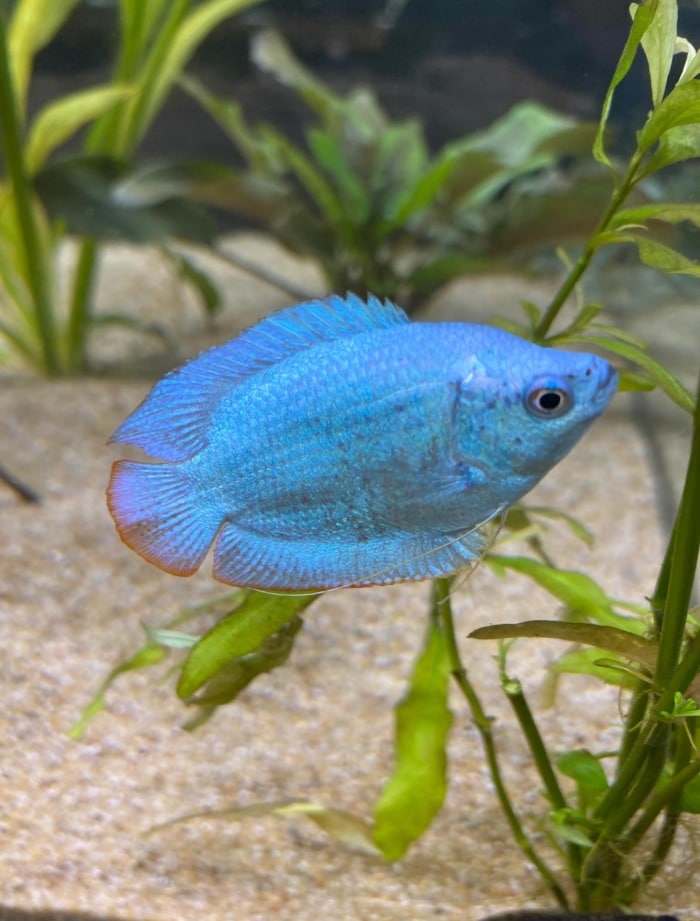
| Max. body size | 3 – 3.5 inches (7.6 cm – 8.9 cm) |
| Suggested tank size | 10+ gallons |
| Water temperature | 73 to 81°F (22.7 to 27.2°C) |
| Setup | Freshwater |
To say the Powdered Blue Dwarf Gourami from the Trichogaster genus is charming would be an understatement.
This stunning dither fish has a turquoise body marked by vertical red stripes, that run all the way to its dorsal and anal fins.
Depending on the lighting, it may also appear to be slightly purple.
I recommend using a dark substrate as it will help its light blue color pop out. Black Diamond Blasting sand is among the best choices for a tank with a brightly-colored Powder Blue Gourami.
This type of blue fish originates from southeast Asia where it inhabits shallow bodies of water with thick vegetation.
However, wild specimens have a far different color pattern than the ones sold at your local fish store.
Like the vast majority of fish in the hobby, those are a result of years of selective breeding.
Author’s note: Just like Betta fish, Gouramis are classified as labyrinth fish and possess a specialized breathing organ which allows them to use atmospheric oxygen. If their tank has a lid it shouldn’t be filled to the top as they will occasionally rise to the surface to gulp for air.
Even though these fish are considered to be relatively shy, they can get territorial and aggressive if they’re kept in pairs.
I recommend that you either stick to female specimens only or keep your powdered dwarf gouramis as the only dither fish in your setup.
You should also keep in mind that these cute blue fish are quite sensitive and easily get stressed by noise and living room traffic.
6. German Blue Ram – Mikrogeophagus ramirezi

| Max. body size | 3 inches (7.6 cm) |
| Suggested tank size | 20 gallons |
| Water temperature | 84 to 86 °F (29 to 30 °C) |
| Setup | Freshwater |
The German Blue Ram is a small and peaceful cichlid species that’s ideal for medium-sized community tanks. It is one of the three recognized species in the Mikrogeophagus genus and has a bright blue body with a yellow-colored head and fins.
Just like the two other members of its genus, the Blue Ram is also marked by a black vertical stripe that runs across its head.
In the wild, these fish inhabit slow-moving bodies of water like streams, ponds, and waterways, with lush vegetation.
Therefore, they require soft, acidic water with a pH of about 5.0 to 7.0 and a dim-lit environment with lots of hiding spots.
7. Blue Gudgeon Dartfish – Ptereleotris heteroptera
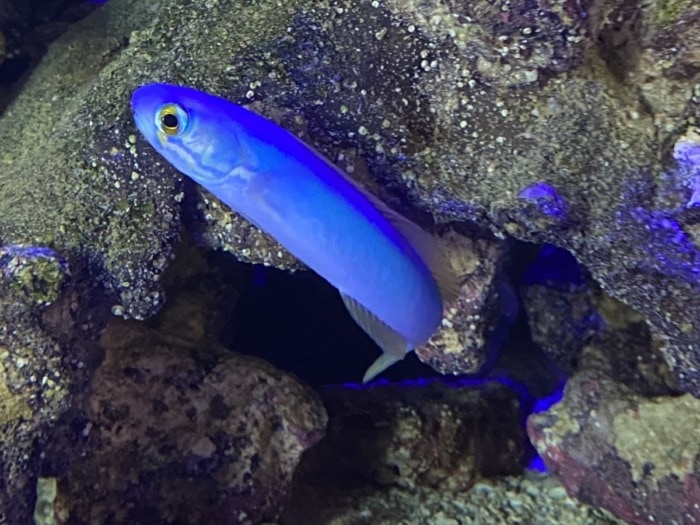
| Max. body size | 5 inches (12.7 cm) |
| Suggested tank size | 30 gallons |
| Water temperature | 72 to 78 °F (22 to 26 °C) |
| Setup | Saltwater |
Blue Gudgeon Dartfish, Blacktail Gobbies, Indigo Dartfish, and Pale Gudgeons all refer to a single species of fish from the Ptereleotris genus. The entire body of this saltwater fish is coated in a bright blue hue, which helps it easily blend in its natural environment and escape predators.
Blue Gudgeon Dartfish are quite timid in nature and shouldn’t be kept near any overaggressive fish that might intimidate them.
They should be provided with a substantial amount of sand substrate which they can use to bury themselves.
This will help them feel more at ease in case they get stressed.
Another thing that will help Blue Gudgeon Dartfish feel more relaxed is to keep them in groups of at least four.
8. Discus Fish – Symphysodon aequifasciatus

| Max. body size | 4.8 to -6 inches (12.3 to -15.2 cm), but some specimens could grow up to 9 inches (23 cm) |
| Suggested tank size | 75 gallons or larger |
| Water temperature | 82 to 86 °F (27 to 30 °C) |
| Setup | Freshwater |
Discus fish come in a variety of color morphs, all of which can easily contend for the title of most beautiful aquarium fish. The Blue Discus from the Symphysodon genus is no exception to this rule.
These fish can be found in several shades of blue ranging from azure and turquoise down to navy blue.
Some specimens may be marked by black vertical stripes, but most usually only possess the typical rosette pattern.
Discus fish are delicate fish that require stable water parameters in order to thrive and show their best colors.
If you’re just starting out your aquarium journey, I wouldn’t recommend them as you’ll likely run into a lot of problems.
9. Palette Surgeonfish – Paracanthurus hepatus

| Max. body size | 9.8 to 12.2 inches (25 to 31 cm) |
| Suggested tank size | 75 gallons |
| Water temperature | 73 to 81 °F (23 to 27 °C) |
| Setup | Saltwater |
Unlike the cognitive capabilities of its cartoon counterpart, the Palette Surgeonfish from the Paracanthurus genus leaves you with a long-lasting impression once you’ve seen it up close. It possesses a vibrant blue body that is nicely complemented by a lemon-colored tail.
The vibrant blend of colors of this marine fish creates a mesmerizing effect and easily draws the attention of both enthusiasts and connoisseurs.
However, the splendor of the Palette Surgeonfish comes at a high cost. These fish require pristine water conditions, which makes them prone to a host of ailments if these conditions aren’t met.
10. Bluefin Notho – Nothobranchius rachovii
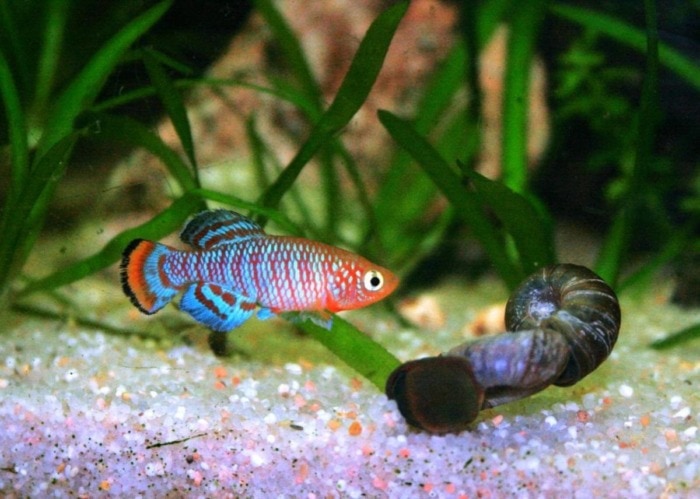
| Max. body size | 2.4 inches (6 cm) |
| Suggested tank size | 10 gallons |
| Water temperature | 68 to 75 °F (20 to 24 °C) |
| Setup | Freshwater |
The body coloration of the Bluefin Notho exemplifies what a perfect blend of blue and orange hues looks like.
Unfortunately, their beauty is short-lived as they can live for no more than a year.
In nature, these fish are found in the floodplains of rivers or water-filled depressions and need to reproduce during the wet season, before the water evaporates.
As a result, this pretty blue fish reaches sexual maturity significantly faster than other fish species and suffers a shorter lifespan.
Due to their rapid lifecycle, it’s preferable to keep Bluefin Nothos in a species-specific tank having two females for every male.
Alternatively, they could be housed with peaceful species such as Corydoras Catfish, Kuhli Loaches, or Black Skirt Tetras.
11. Lake Kutubu Rainbowfish – Melanotaenia lacustris

| Max. body size | 4 to 4.8 inches (10 to 12 cm) |
| Suggested tank size | 60 gallons |
| Water temperature | 68 to 77 °F (20 to 25 °C) |
| Setup | Freshwater |
This aptly named Rainbowfish is endemic to lake Kutubu in Papua New Guinea where it gathers around aquatic vegetation and submerged roots.
It belongs to the Melanotaenia genus, and just like most of its members, it has a rather bulky frame which may intimidate smaller fish.
Despite their imposing stature, these fish are in fact, quite peaceful.
This makes them a great tank mate for a variety of closely-sized freshwater species like gobies, danios, barbs, and catfish.
Lake Kutubu Rainbowfish have a metallic blue coloration which is most intense when they’re kept in schools of at least six fish. Keeping them in a planted tank also helps to bring out their colors.
12. Blue Gularis Killifish – Fundulopanchax sjoestedti
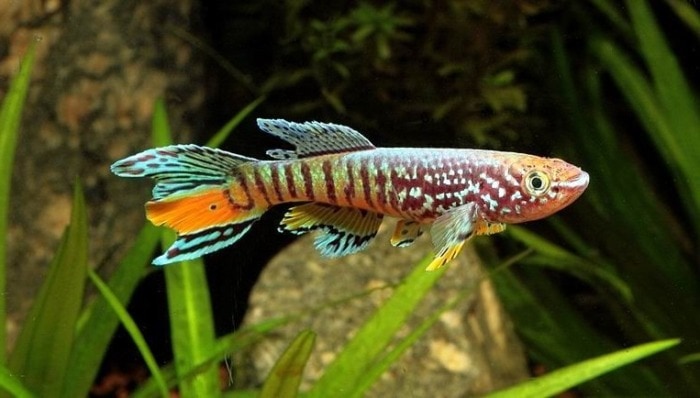
| Max. body size | 5 inches (12.7 cm) |
| Suggested tank size | 20 gallons |
| Water temperature | 73 to 79 °F (22 to 26 °C) |
| Setup | Freshwater |
The Blue Gularis Killifish from the Fundulopanchax genus has a stunning multicolored body with a range of different geometrical patterns scattered across it. Males usually display more saturated blue and orange coloration, while females have smaller bodies and a duller gray-brown patterning.
Blue Gularis Killifish are known to be jumpers, so you should keep them under a tight lid.
13. Cherub Pygmy Angelfish – Centropyge argiare
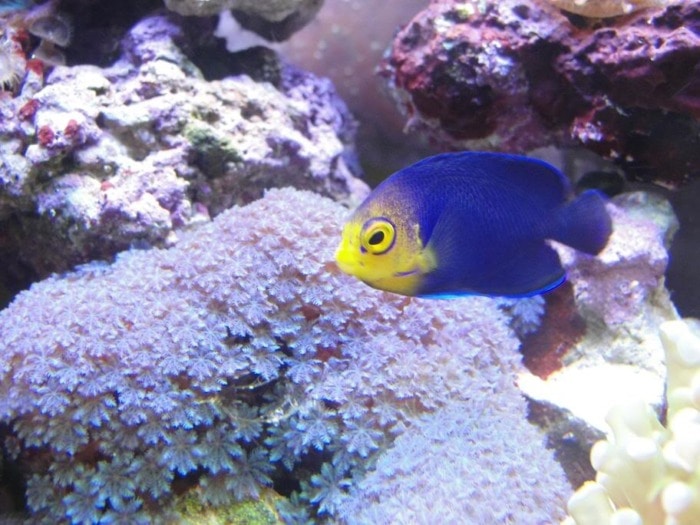
| Max. body size | 3.2 inches (8 cm) |
| Suggested tank size | At least 55 gallons |
| Water temperature | 72 to 82 °F (22 to 28 °C) |
| Setup | Saltwater |
Don’t let the name of these fish fool you as they’re anything but angelic.
Cherub Pygmy Angelfish from the Centropyge genus are violent fish that are indiscriminate to species.
If an opportunity for a scuffle presents itself, they will gladly indulge in the mayhem that it ensues.
Be that as it may, these fish do possess some redeeming qualities, one of which is their beauty.
Cherub Pygmy Angelfish can be distinguished by their sapphire blue body tone which overflows to yellow at their head.
Their compelling color palette is complemented by the aesthetic, round shape of their body.
If you’re ready to sacrifice your peace of mind for the beauty of these blue marine fish, then you would need to provide them with a sufficient amount of hiding spots such as caves and rocks.
You should also keep only one male specimen and house them with larger tank mates that they wouldn’t harass.
14. Blue Peacock Cichlid – Aulonocara nyassae
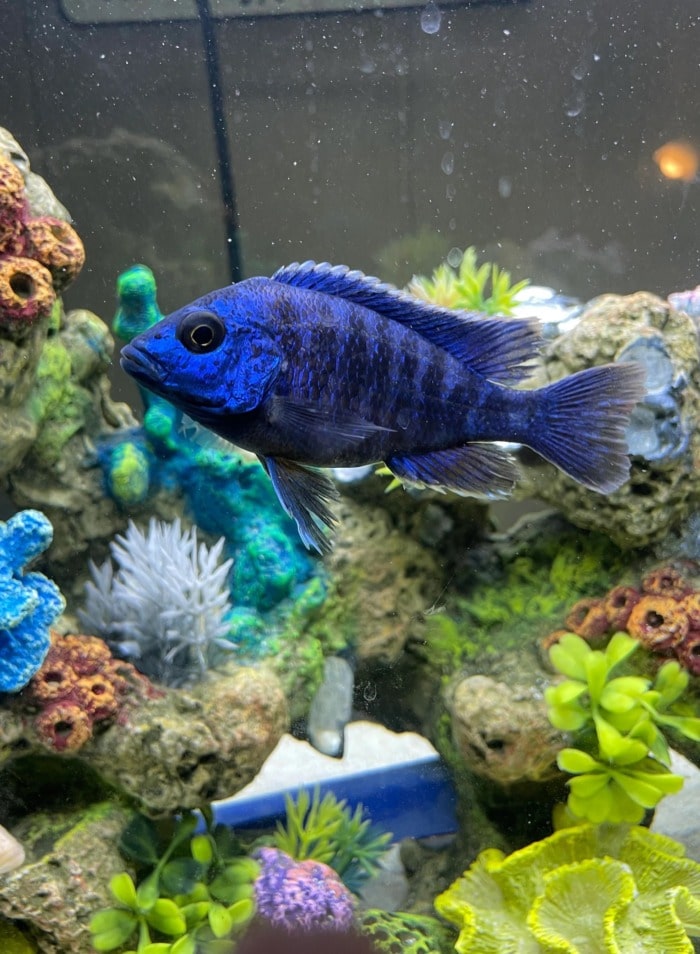
| Max. body size | 6 inches (15 cm) |
| Suggested tank size | 55 gallons |
| Water temperature | 75 to 82 °F (24 to 28 °C) |
| Setup | Freshwater |
The Blue Peacock Cichlid is one of several cichlid species that inhabit Lake Malawi in East Africa.
Unlike most of the other African cichlids that inhabit the same lake, it is tolerant to other species of fish. Its tolerance however doesn’t extend to fish of its own kind.
Males will become aggressive and fight each other if there aren’t enough females.
To keep their violent tendencies at bay, you should always have at least four females for every male specimen in your aquarium.
Male Peacock Cichlids can be easily distinguished from females by their blue-striped bodies and pointed fins.
In contrast, females are golden yellow and have rounded fins.
15. Yellowtail Blue Damselfish – Chrysiptera parasema
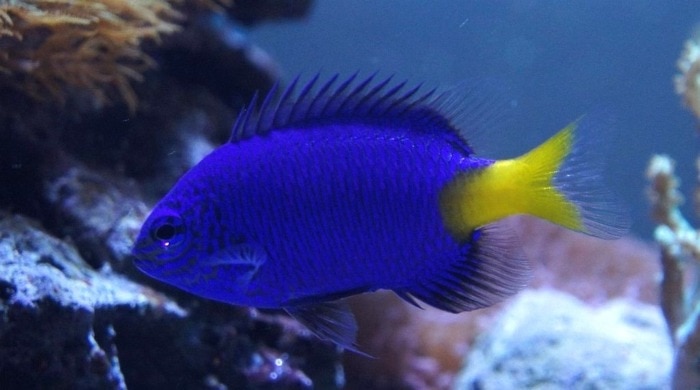
| Max. body size | 2.7 inches (7 cm) |
| Suggested tank size | At least 20 gallons for a single specimen |
| Water temperature | 75 to 82 °F (24 to 28 °C) |
| Setup | Saltwater |
Adored by both beginner and advanced aquarists alike, the Yellowtail Blue Damselfish is a tiny yet gorgeous saltwater fish and is arguably the finest species from the Chrysiptera genus. Unlike other members of the same genus, this blue and yellow fish is less aggressive and can be housed in smaller tanks.
A single specimen can be kept in a 20-gallon tank, as long as it’s the only fish in the aquarium.
Housing multiple ones would require a larger tank and a careful selection of tank mates, as these fish are still relatively aggressive.
Yellowtail Damselfish usually come in sapphire blue or turquoise, but some specimens can also be found in darker hues of blue.
Author’s note: Just as with most clownfish species, male Yellowtail Damselfish are responsible for taking care and guarding the eggs. Because of this, males become very aggressive and territorial during the spawn.
16. Pygmy Sunfish – Elassoma gilberti
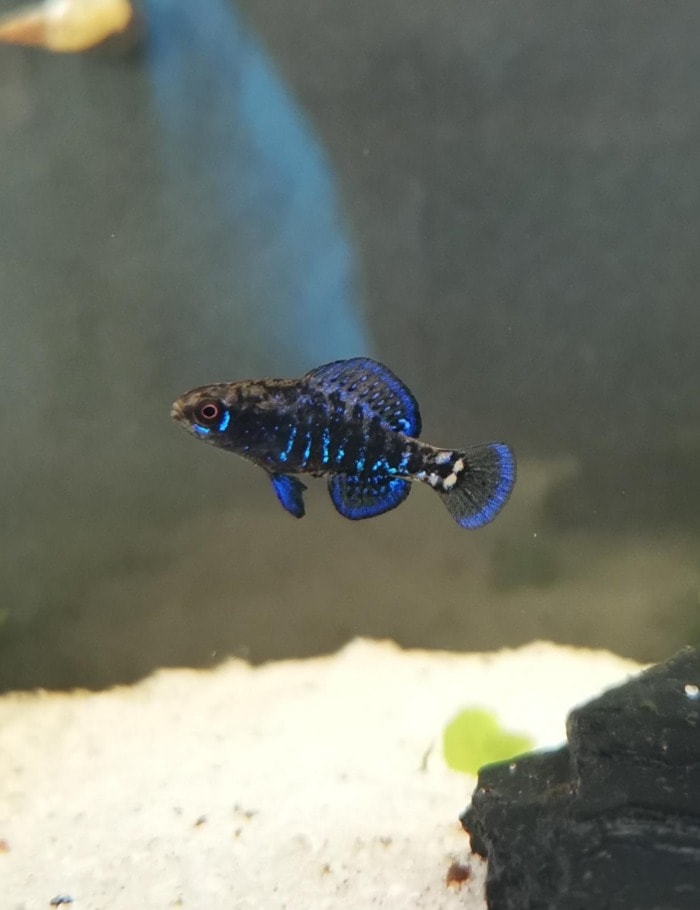
| Max. body size | 1 inch (2.5 cm) |
| Suggested tank size | 5 gallons for a single male and 2 females or 20+ gallons for a group of 6 fish |
| Water temperature | 68 to 74.3 °F (20 to 23.5 °C) |
| Setup | Freshwater |
Although their bodies are primarily brown, Pygmy Sunfish from the Elassoma genus have brightly colored blue fins that create a pleasant contrast.
In the wild, this small blue fish inhabits sluggish streams, canals, and ponds that are low in oxygen.
Its inherent hardiness along with its peaceful nature makes it an excellent choice for entry-level hobbyists.
However, beginners might still face some difficulties because of their pickiness in terms of food.
Pygmy Sunfish prefer eating live foods and should ideally be fed with small pest snails and micro-worms or insect larvae. The minute size of these pet fish also makes them an ideal choice for nano tanks.
17. Electric Blue Jack Dempsey – Rocio octofasciata

| Max. body size | 10 inches (25.4 cm) |
| Suggested tank size | At least 55 gallons for one fish |
| Water temperature | 74 to 81 °F (23 to 28 °C) |
| Setup | Freshwater |
The iridescent electric blue spangles of the Jack Dempsey cichlid are certainly eye-catching, but what’s more interesting about them is that their color darkens when the Jack Dempsey becomes aggressive.
Even though the electric variant of the Jack Dempsey is considered to be less aggressive than the other ones, it still possesses the same belligerent nature as them.
If they’re given the chance, these fish will harass smaller tank mates in an effort to establish dominance.
For this reason, they should either be kept in species-specific tanks or with fish having similar behavioral patterns like Rainbowfish or Jewel Cichlids.
In contrast to their violent nature, these blue tropical fish can be great parents, at least as far as fish go.
Unlike other cichlids, they rarely eat their fry and are even known to pre-chew food for their babies. Though some consider the Jack Dempsey cichlid to be intermediate in terms of care requirements, I’ve found that with a bit of reading beforehand they’re not that difficult to look after, even for a beginner.
18. Paradise Fish – Macropodus opercularis
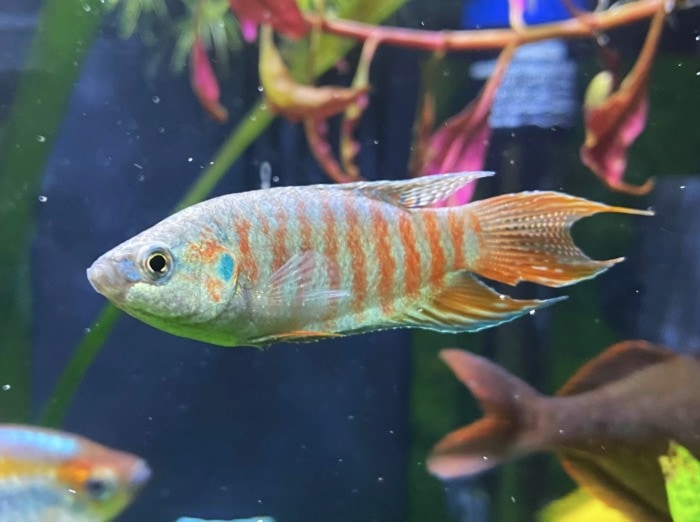
| Max. body size | 4 inches (10.1 cm) |
| Suggested tank size | At least 20 gallons for a single Paradise Gourami |
| Water temperature | 61 to 75 °F (16 to 24 °C) |
| Setup | Freshwater |
The Paradise Fish from the Macropodus genus are not only beautiful but useful as well. These blue-orange fish are widely known for their ability to eat aquatic pest snails in their aquarium.
Despite their usefulness for pest snail infestations, however, many aquarists disregard them because of their aggressive behavior.
Paradise Fish exhibit aggression to both conspecific and non-specific fish species.
Because of this, in the past Paradise Fish were used in fights across China. In this sense, they’re similar to Bettas whose violent nature was also exploited as a form of gambling in Thailand.
If you’re prepared to deal with their occasional destructive outbursts, you’ll get a stunning specimen that can easily be turned into a centerpiece for your fish tank.
Its alternating blue and orange stripes, along with its fan-shaped tail will make it stand out regardless of its environment.
19. Electric Blue Acara – Andinoacara pulcher

| Max. body size | 6 inches (15.2 cm) |
| Suggested tank size | 30-gallon tank at minimum |
| Water temperature | 72 – 82 °F (22.2 – 27.7 °C) |
| Setup | Freshwater |
The Electric Blue Acaras from the Andinoacara genus, bear almost none of the violent behaviors that are typical for their cousins.
While it’s true that they can get a bit aggressive during mating, these blue tropical fish will rarely if ever attack another tank mate under different circumstances.
Having this in mind, it’s worth noting that Blue Acaras are still predatory fish and will try to eat any fish that’s small enough to fit in their mouth. Therefore, they should be housed with other non-aggressive fish of relative size.
Black Skirt Tetras, Congo Tetras, and Corydoras Catfish are just a few of the fish species that fit this bill.
To keep the saturated electric blues of your acaras, you should feed them with high-protein foods.
Final Thoughts
Those were my top picks for blue fish that you can beautify your aquarium with.
What about yours?
Feel free to share them in the comments.
And just a quick note from my personal experience – blue species combine very well with orange ones.


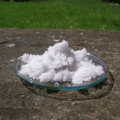

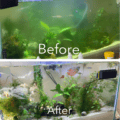
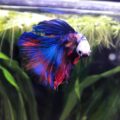
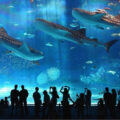

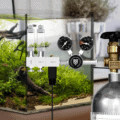

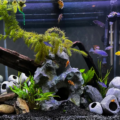
1 thought on “19 Captivating Blue Aquarium Fish of All Types”